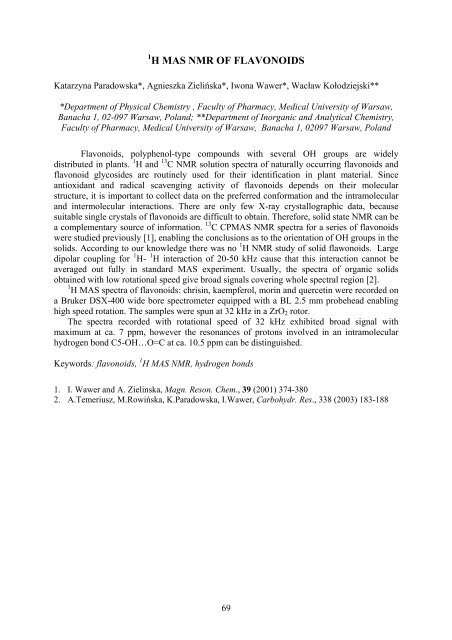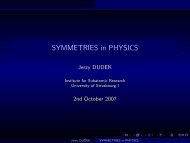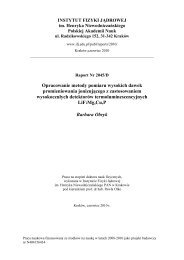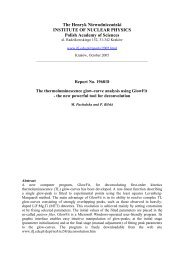Report No xxxx - Instytut Fizyki JÄ drowej PAN
Report No xxxx - Instytut Fizyki JÄ drowej PAN
Report No xxxx - Instytut Fizyki JÄ drowej PAN
You also want an ePaper? Increase the reach of your titles
YUMPU automatically turns print PDFs into web optimized ePapers that Google loves.
1 H MAS NMR OF FLAVONOIDS<br />
Katarzyna Paradowska*, Agnieszka Zielińska*, Iwona Wawer*, Wacław Kołodziejski**<br />
*Department of Physical Chemistry , Faculty of Pharmacy, Medical University of Warsaw,<br />
Banacha 1, 02-097 Warsaw, Poland; **Department of Inorganic and Analytical Chemistry,<br />
Faculty of Pharmacy, Medical University of Warsaw, Banacha 1, 02097 Warsaw, Poland<br />
Flavonoids, polyphenol-type compounds with several OH groups are widely<br />
distributed in plants. 1 H and 13 C NMR solution spectra of naturally occurring flavonoids and<br />
flavonoid glycosides are routinely used for their identification in plant material. Since<br />
antioxidant and radical scavenging activity of flavonoids depends on their molecular<br />
structure, it is important to collect data on the preferred conformation and the intramolecular<br />
and intermolecular interactions. There are only few X-ray crystallographic data, because<br />
suitable single crystals of flavonoids are difficult to obtain. Therefore, solid state NMR can be<br />
a complementary source of information. 13 C CPMAS NMR spectra for a series of flavonoids<br />
were studied previously [1], enabling the conclusions as to the orientation of OH groups in the<br />
solids. According to our knowledge there was no 1 H NMR study of solid flawonoids. Large<br />
dipolar coupling for 1 H- 1 H interaction of 20-50 kHz cause that this interaction cannot be<br />
averaged out fully in standard MAS experiment. Usually, the spectra of organic solids<br />
obtained with low rotational speed give broad signals covering whole spectral region [2].<br />
1 H MAS spectra of flavonoids: chrisin, kaempferol, morin and quercetin were recorded on<br />
a Bruker DSX-400 wide bore spectrometer equipped with a BL 2.5 mm probehead enabling<br />
high speed rotation. The samples were spun at 32 kHz in a ZrO 2 rotor.<br />
The spectra recorded with rotational speed of 32 kHz exhibited broad signal with<br />
maximum at ca. 7 ppm, however the resonances of protons involved in an intramolecular<br />
hydrogen bond C5-OH…O=C at ca. 10.5 ppm can be distinguished.<br />
Keywords: flavonoids, 1 H MAS NMR, hydrogen bonds<br />
1. I. Wawer and A. Zielinska, Magn. Reson. Chem., 39 (2001) 374-380<br />
2. A.Temeriusz, M.Rowińska, K.Paradowska, I.Wawer, Carbohydr. Res., 338 (2003) 183-188<br />
69

















